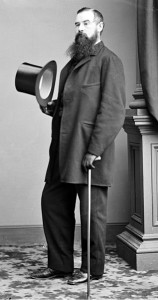The Gospel of the Witches: Missing or Faked? April 6, 2012
Author: Beach Combing | in : Modern , trackbackBeach is not waving but drowning in the flood of work, but the summer is coming closer and – oh wonderful – closer. Soon he’ll be able to settle down to four months of light teaching and heavy research. Most of the cherry-blossom time will be given over to fairies. However, Beach has also been sniffing around the books of one Charles Leland (obit 1903). Leland, for those who have not heard of him, was an American who spent several years in Florence towards the end of his life. His writings ranged from ‘mere’ journalism, to work on the gypsies, to humorous pastiches, to discussions of the legend of Virgil. However, in his last decade he rounded off his scholarship with three works on witchcraft and popular belief in central Italy: these books have given him what immortality he now enjoys.
Leland had as his main source here a Tuscan witch called Maddalena (not her real name). Now the whole question of whether there were any Tuscan witches at this date is a controversial one: there are extremists who argue that there never were Tuscan witches and that even in the ‘burning years’ the trials and the deaths were all the result of hysterical inquisitors. This is going too far but were there really wise old women in late nineteenth-century Tuscany following a pagan religion: and this a generation before Margaret Murray got so delightfully het up about the whole question? Certainly, there is a case to be made that such witches as existed were confidence tricksters and shysters rather than minions of Diana.
Maddalena backed up, though, her claims with references to a book known as the Gospel of the Witches. She first mentioned this book to Leland in 1886 (he claims). But it was only in 1899 that he finally got his hands on a copy (sent by Maddalena) and went ahead and published it. This is Leland’s background to the gospel.
However, [old beliefs] die slowly, and even yet there are old people in the Romagna of the North who know the Etruscan names of the Twelve Gods, and invocations to Bacchus, Jupiter, and Venus, Mercury, and the Lares or ancestral spirits, and in the cities are women who prepare strange amulets, over which they mutter spells, all known in the old Roman time, and who can astonish even the learned by their legends of Latin gods, mingled with lore which may be found in Cato or Theocritus. With one of these [Maddalena] I became intimately acquainted in 1886, and have ever since employed her specially to collect among her sisters of the hidden spell in many places all the traditions of the olden time known to them. It is true that I have drawn from other sources, but this woman by long practice has perfectly learned what few understand, or just what I want, and how to extract it from those of her kind. Among other strange relics, she succeeded, after many years, in obtaining the following ‘Gospel’, which I have in her handwriting… I do not know definitely whether my informant derived a part of these traditions from written sources or oral narration, but believe it was chiefly the latter. However, there are a few wizards who copy or preserve documents relative to their art. I have not seen my collector since the ‘Gospel’ was sent to me. I hope at some future time to be better informed.
The key question, of course, is: did this book exist or was it just a product of Leland’s imagination? Leland himself admitted in his work to being ‘bitter’ at the lack of interest in his previous works on witchcraft: perhaps the Gospel was an attempt to convince scholars? However, if the manuscript did not exist then Leland made a very good job of pretending that it did. He translated much of it in his Aradia or the Gospel of the Witches. He also included the Italian in some cases. Unfortunately, the manuscript itself does not survive: if it could be found in an archive it would be the Holy Grail of modern Wicca-types who derive many of their ceremonies from Aradia and who get a little irate when scholars dismiss it out of hand.
Of course, even if the manuscript was dug up there would be another question: was it a genuine object handed down from hand to hand, or one created by Maddalena to sell to her American patsy? It is here that Beachcombing would have suspicions. Maddalena was no illiterate. Elsewhere Leland writes ‘Maddalena has written me her self about 200 pages of this folk-lore incantations and stories. It is a good thing that she likes to collect and write.’ In a later letter he writes that he paid her five francs a week for collecting. Not bad money for the 1890s. Then as Leland himself writes above: ‘this woman by long practice has perfectly learned what few understand, or just what I want’. It would be a curiosity if one of the pillars of modern Wicca was built on the creativity of a Tuscan cardsharp: the manuscript remember was in her handwriting.
Any other perspectives on the lost (or never existing) Gospel of the Witches: drbeachcombing AT yahoo DOT com



